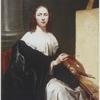More about Two Girls as Saint Agnes and Saint Dorothy

Contributor
For centuries, the art of Michaelina Wautier was lost to the annals of history.
Looking at this painting, you might be scratching your head and asking yourself, “But why?”, because Wautier’s talents were clearly more than a match for those household names like Peter Paul Rubens and Anthony van Dyck. Today, art aficionados like to refer to her as “Baroque’s leading lady,” but up until the mid-1990s nobody so much as remembered her name. For years, her paintings were all either gathering dust in storage or being misattributed to other artists (more often than not her brother Charles...typical), and one of her self-portraits was even falsely credited to fellow Baroque artist Artemisia Gentileschi. Come on art historians, get it together! They don’t even look that much alike.
Nonetheless, Wautier was a fairly successful and well-regarded artist during her lifetime—an unusual feat for a woman living in the 17th century. Woman artists at the time were encouraged to limit themselves to traditionally “feminine” subjects (like, you know, flowers). Although Wautier did indeed paint flowers from time to time, she’s known for working in an unusually wide variety of genres, such as vast mythic scenes like the one depicted in Triumph of Bacchus, portraits of military officers, and religious paintings like this one.
Although we have no way of knowing who the two little girls in this portrait were, we do know a little bit about Saint Agnes and Saint Dorothea. To understand why Wautier was painting her sitters in the guise of Saints at all, though, it’s important to first know a little bit about what the Baroque movement was all about. The Baroque—which wasn’t limited to the visual arts, but also had an influence on architecture, music, dance, and literature—arose in response to the Protestant Reformation in the North. It was basically designed to promote the Catholic Church through dramatic, ornate, and emotionally charged images that appealed directly to emotions and carried a clear message. While Protestants were highly suspicious of the cult of images, Catholics fully embraced the power of art to sway viewers to religious feelings, and weren’t afraid to make art that was a tad over-the-top in the name of promoting their faith.
Although not all Baroque art featured explicitly religious subjects (still lifes and mythological scenes were also popular), bible stories and saints were favorite subjects of the time. Portraits in which the sitter was shown in the guise of a biblical or mythological figure, called portrait historiés, were also very popular. Both Saint Agnes and Saint Dorothea would have been seen as ideal figures for young girls to model themselves after, since they were remembered for their chastity and devotion to Christ. The girls’ downcast eyes could be interpreted as representing their modesty and humility. It was also an unusual stylistic choice on Wautier’s part, since at the time it was the norm to depict portrait sitters looking directly at the viewer.
The girl on the right is recognizable as Saint Agnes, patron saint of girls and chastity, due to her pet lamb, which symbolizes her innocence. Saint Agnes had a pretty gruesome martyrdom. According to legends, she was a member of the Roman nobility, born into a Christian family in 291 AD and martyred at 12 or 13. She was very pretty and all the men were in love with her (even though she was a child, but things were different back then, I guess). She didn’t like any of them back though, and besides, she’d already decided she wanted to live a life of religious purity, and considered herself practically married to Jesus. But these men were petty, and took her rejection personally, so they decided to completely screw her over by reporting her as a follower of Christianity, which was still an illegal cult at the time. As a “punishment” she was condemned to be dragged through the streets naked to a brothel, but when she prayed her hair grew long enough to cover up her nakedness, protecting her modesty. The good news was that all of the men were so overawed by her beauty and purity that they left her alone—well, except for one, who tried to rape her and as a result was immediately struck blind. When they tried to burn her at the stake, the wood wouldn’t catch fire, so they had to kill her by cutting off her head instead. (Such a cool time to be a woman.)
The legend of Saint Dorothea’s martyrdom is only a bit less florid. She lived around the same time as Agnes, also taking a vow of virginity and refusing to wed because she considered herself married to Jesus. When she was sentenced to death for being a Christian, the pagan lawyer Theophilus mockingly said to her, “Bride of Christ, send me some fruits from your bridegroom’s garden” (meaning from Jesus’s garden), assuming it was an impossible request...but Dorothea did just as he asked. Right before she died, she sent a six-year-old boy to Theophilus with her headdress, which was, according to the story, filled with a rich fragrance of roses and fruits. When Theophilus drank in the heavenly scent, he immediately converted to Christianity and was put to death along with Dorothea.
Just as the rich scents buried in Saint Dorothea’s headdress convinced Theophilus to convert to Christianity, so the decadent jewel-tones and rich draperies in this painting entice the viewer into a pious frame of mind. Although Wautier does this much more quietly than, say, Caravaggio, with his red-tinged dramas of stark light and shadow, Wautier was still just as masterful at evoking religious grandeur in her art as the next Baroque artist. It really is a shame we forgot about her for so long—but thankfully, her work is back in the spotlight now, exactly where it belongs.
Sources
- Camara, Esperança. “Baroque art, an introduction.” Smarthistory. June 9, 2015. Accessed October 28, 2020. https://smarthistory.org/a-beginners-guide-to-baroque-art/
- McCouat, Philip. “Forgotten Women Artists #4: Michaelina Wautier: entering the limelight after 300 years.” Journal of Art in Society, April 2019. Accessed October 28, 2020. http://www.artinsociety.com/forgotten-women-artists-4-michaelina-wautie…
- McEwan, Olivia. “The Criminally Overlooked Talent of Baroque Painter Michaelina Wautier.” Hyperallergic, August 15, 2018. Accessed October 28, 2020. https://hyperallergic.com/455577/the-criminally-overlooked-talent-of-ba…- michaelina-
- Solly, Mellan. “‘Baroque’s Leading Lady’ Artist Michaelina Wautier Finally Gets Retrospective.” Smithsonian Magazine, August 17, 2018. Accessed October 28, 2020. https://www.smithsonianmag.com/smart-news/antwerp-hosts-first-retrospec…- dedicat
- “Two Girls as Saint Agnes and Saint Dorothea.” KMSKA. Accessed October 28, 2020. https://kmska.be/en/collection/artworks/two-girls-as-saint-agnes-and-sa….
Featured Content
Here is what Wikipedia says about Two Girls as Saint Agnes and Saint Dorothea
Two Girls as Saint Agnes and Saint Dorothea is a painting by the Walloon artist Michaelina Wautier. It was probably painted in the 1650s.
It now hangs in the Royal Museum of Fine Arts, Antwerp.
Check out the full Wikipedia article about Two Girls as Saint Agnes and Saint Dorothea












